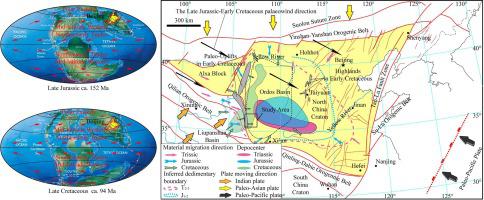Journal of Asian Earth Sciences ( IF 2.7 ) Pub Date : 2021-07-14 , DOI: 10.1016/j.jseaes.2021.104896 Yin Chen 1, 2, 3 , Jianguo Li 4 , Peisen Miao 2, 3 , Lulu Chen 2, 3 , Hualei Zhao 2, 3 , Cong Wang 5

|
The Ordos Basin is located in the western part of the North China Craton, and was developed based on Paleozoic shallow marine sediments and Mesozoic continental deposits. In the southwestern Ordos Basin (SWOB), Paleozoic to Mesozoic sedimentary successions are well preserved and display variable deformation. However, the Cretaceous source-to-source evolution of the SWOB is poorly known but is significant to understand the tectonic evolution of the Ordos Basin. In this study, U–Pb ages and Hf isotopic analyses on detrital zircons from sandstones of the Cretaceous succession in the SWOB were performed, with an aim to trace the Cretaceous sediment provenances and the tectonic–paleogeographic configuration of the Ordos Basin. The new analyses clearly reveal four major age peaks for detrital zircons from Cretaceous sedimentary rocks in the SWOB: 274, 438, 1852, and 2474 Ma, and two minor peaks at 880–950 Ma and >3000 Ma. These zircons have εHf(t) values with a normal distribution from −15.8 to 11.4 and TDM2 ages with multiple peaks mostly at 2985–2720 Ma. Combined with the paleogeographic reconstruction and tectonic evolution of the Ordos Basin, the isotopic analyses prove that the detrital zircons in the Cretaceous succession were mostly sourced from the Alxa Block, Qilian Orogenic Belt, and Yinshan Orogenic Belt, and secondarily from the Qinling Orogenic Belt. Influenced by the formation of the Late Jurassic-Early Cretaceous paleo-uplifts, the Cretaceous sedimentary rocks in the SWOB were sourced from these paleo-uplifts and recycled from the underlying pre-Cretaceous rocks situated in the western Ordos Basin. The migration of the Mesozoic sedimentary depocenter and provenance in the Ordos Basin was controlled by the regional compression of multiple directions.
中文翻译:

鄂尔多斯盆地西南部白垩系碎屑锆石U-Pb年龄和Hf同位素对物源和构造演化的意义
鄂尔多斯盆地位于华北克拉通西部,以古生代浅海相沉积和中生代陆相沉积为主。在鄂尔多斯盆地西南部(SWOB),古生代至中生代沉积序列保存完好,变形可变。然而,SWOB 的白垩纪源到源演化知之甚少,但对于了解鄂尔多斯盆地的构造演化具有重要意义。在这项研究中,对 SWOB 白垩纪系列砂岩碎屑锆石进行 U-Pb 年龄和 Hf 同位素分析,旨在追踪鄂尔多斯盆地的白垩纪沉积物来源和构造古地理配置。新的分析清楚地揭示了 SWOB 中白垩纪沉积岩碎屑锆石的四个主要年龄峰值:274、438、1852 和 2474 Ma,以及 880-950 Ma 和 >3000 Ma 的两个小峰。这些锆石有 εHf ( t ) 值具有从 -15.8 到 11.4 的正态分布和 T DM2多峰年龄主要在 2985-2720 Ma。结合鄂尔多斯盆地古地理重建和构造演化,同位素分析证明白垩系系列碎屑锆石主要来源于阿拉善地块、祁连造山带和银山造山带,其次来源于秦岭造山带。受晚侏罗世-早白垩世古隆起形成的影响,西南盆地白垩纪沉积岩来源于这些古隆起,并从位于鄂尔多斯盆地西部的下伏前白垩纪岩石中回收。鄂尔多斯盆地中生代沉积沉积中心和物源迁移受多向区域挤压控制。









































 京公网安备 11010802027423号
京公网安备 11010802027423号